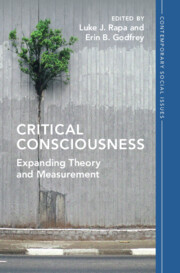Book contents
- Critical Consciousness
- Contemporary Social Issues
- Critical Consciousness
- Copyright page
- Dedication
- Contents
- Figures
- Tables
- Contributors
- Acknowledgments
- Introduction Critical Consciousness Theory and Measurement
- Part I Theory
- 1 Synthesizing Critical Consciousness and Identity-Based Motivation to Clarify How Youth of Color Navigate and Challenge Racial Capitalism
- 2 Situating Critical Consciousness Within the Developmental System
- 3 Integrating Critical Consciousness and Social Empathy
- 4 Critical Consciousness in Early to Middle Childhood
- 5 Adolescents’ Developmental Pathways to Critical Consciousness in the Contexts of Racial Oppression and Privilege
- 6 Making Reflection Critical
- Part II Measurement
- Conclusion Expanding Critical Consciousness Theory and Measurement
- Index
- References
6 - Making Reflection Critical
Structural and Historical Attributions for Inequity
from Part I - Theory
Published online by Cambridge University Press: 20 April 2023
- Critical Consciousness
- Contemporary Social Issues
- Critical Consciousness
- Copyright page
- Dedication
- Contents
- Figures
- Tables
- Contributors
- Acknowledgments
- Introduction Critical Consciousness Theory and Measurement
- Part I Theory
- 1 Synthesizing Critical Consciousness and Identity-Based Motivation to Clarify How Youth of Color Navigate and Challenge Racial Capitalism
- 2 Situating Critical Consciousness Within the Developmental System
- 3 Integrating Critical Consciousness and Social Empathy
- 4 Critical Consciousness in Early to Middle Childhood
- 5 Adolescents’ Developmental Pathways to Critical Consciousness in the Contexts of Racial Oppression and Privilege
- 6 Making Reflection Critical
- Part II Measurement
- Conclusion Expanding Critical Consciousness Theory and Measurement
- Index
- References
Summary
Critical consciousness (CC) theory emphasizes a form of reflection on social, political, and economic conditions that analyzes the historical root causes of inequity and the ways these inequities are systemically perpetuated and magnified through laws, policies, and institutions. Despite the theoretical centrality of structural and historical thinking in CC, most empirical work on the topic has not incorporated these constructs into measures of critical reflection. The current chapter explores the rationale for measuring structural and historical thinking in critical reflection and considers challenges to doing so. We present factor analytic work showing how new measures of structural and historical attributions can be incorporated into existing measurement of critical reflection. We discuss strengths and weaknesses of this approach and explore the implications of this expanded measure.
Keywords
- Type
- Chapter
- Information
- Critical ConsciousnessExpanding Theory and Measurement, pp. 145 - 170Publisher: Cambridge University PressPrint publication year: 2023
References
- 3
- Cited by

